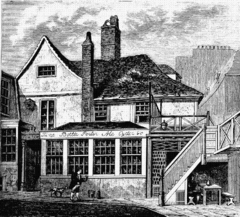London Beer Flood

Toten Hall house in Tottenham Court Road.
|
|
| Date | 17 October 1814 |
|---|---|
| Location | St. Giles, London, England |
| Coordinates | 51°31′00″N 0°07′49″W / 51.51656°N 0.13014°WCoordinates: 51°31′00″N 0°07′49″W / 51.51656°N 0.13014°W |
| Cause | Structural failure |
| 8 dead | |
| Unknown number injured | |
The London Beer Flood happened on 17 October 1814 in the parish of St. Giles, London, England. At the Meux and Company Brewery in Tottenham Court Road, a huge vat containing over 135,000 imperial gallons (610,000 L) of beer ruptured, causing other vats in the same building to succumb in a domino effect. As a result, more than 323,000 imperial gallons (1,470,000 L) of beer burst out and gushed into the streets. The wave of beer destroyed two homes and crumbled the wall of the Tavistock Arms pub, killing teenage employee Eleanor Cooper under the rubble. Within minutes neighbouring George Street and New Street were swamped, killing a mother and daughter who were taking tea, and beer surged through a room of people gathered for a wake.
The brewery was among the poor houses and tenements of the St Giles Rookery, where whole families lived in basement rooms that quickly filled with beer. At least eight people were known to have drowned in the flood or died from injuries.
The brewery was eventually taken to court over the accident, but the disaster was ruled to be an Act of God by the judge and jury, leaving no one responsible. There were speculations of corruption regarding the court ruling but no official statement was made. The company found it difficult to cope with the financial implications of the disaster, with a significant loss of sales made worse because they had already paid duty on the beer. They made a successful application to Parliament reclaiming the duty which allowed them to continue trading.
The brewery was demolished in 1922, and the Dominion Theatre later occupied part of the site. In 2012, a local pub, the Holborn Whippet, started to mark this event with a vat of porter brewed especially for the day.
...
Wikipedia
